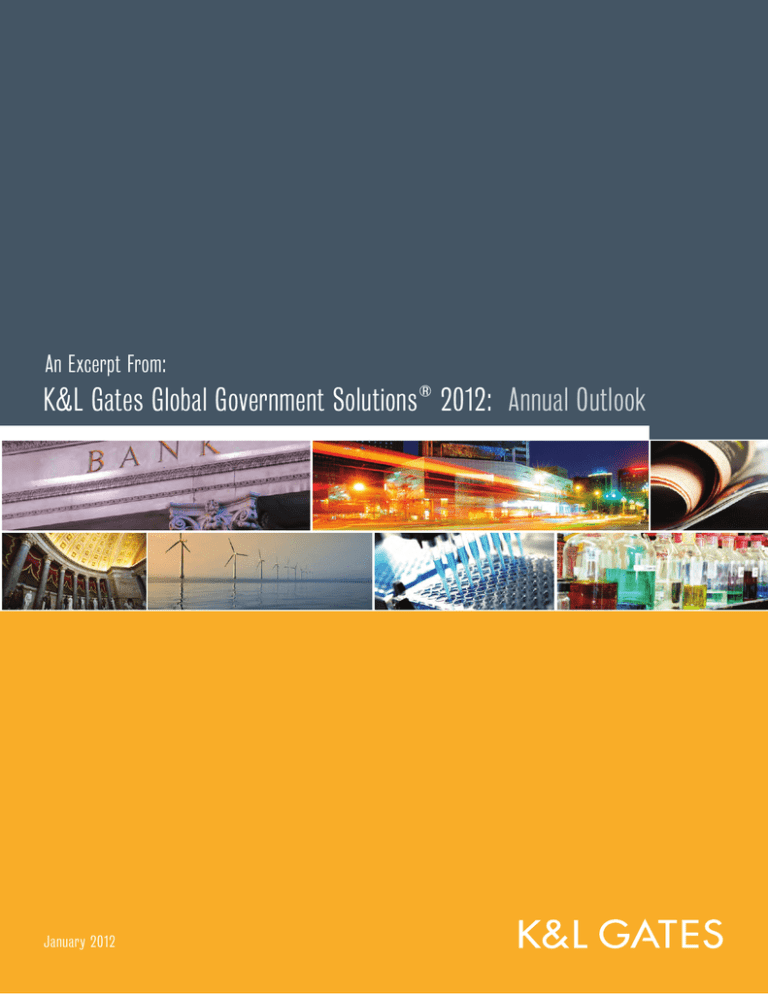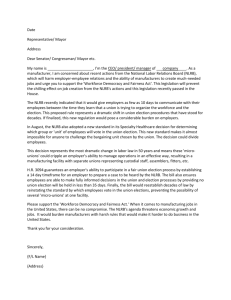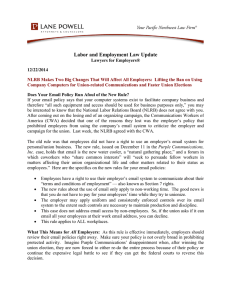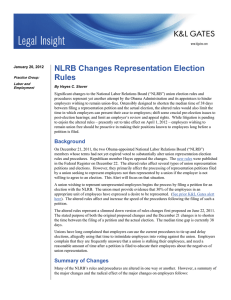
An Excerpt From:
K&L Gates Global Government Solutions ® 2012: Annual Outlook
January 2012
Labor and Employment
Labor Unions Gain Support Through Administrative Actions
During the 2008 presidential campaign, then-candidate Barack Obama pledged
his continued support for the Employee Free Choice Act (EFCA), a bill he had
co-sponsored in the Senate. The EFCA would have made it easier for labor
unions to organize private sector workforces in the United States by, among other
things, allowing unions to be certified as the exclusive bargaining representative
of a workforce based on authorization cards presented by the union and without
the need for a secret ballot election. The EFCA was controversial and met with
stiff resistance in Congress. In a question-and-answer session on September 13,
2010, President Obama stated that while his administration continued to support
the EFCA, its likelihood of passage that term was “not real high,” since, “[f]rankly,
we don’t have 60 votes in the Senate” to pass it. Instead, President Obama
told the group that his administration was trying to do “as much as we can
administratively to make sure that it’s easier for unions to operate and that they’re
not being placed at an unfair disadvantage.” In other words, what the Obama
administration was unable to accomplish through the legislative process it was
attempting to accomplish administratively.
Since the president gave those remarks
in September 2010, the National
Labor Relations Board (NLRB or Board),
the agency that administers federal
law governing private sector employerunion relations in the United States,
has taken a number of unprecedented
steps in apparent fulfillment of this
directive to make it easier for unions to
organize employees.
office conducts a secret ballot election
to determine if a majority of employees
in the unit wish to be represented by
the union. In cases where parties do
not agree on terms of the election, the
Board’s regional office will conduct a
pre-election hearing and, if necessary,
conduct a post-election hearing to resolve
challenges to voters or objections to the
conduct of the election.
Proposed Rulemaking to Speed Up
Elections
On June 21, 2011, the NLRB proposed
a rule that would dramatically shorten
the time between the filing of a union’s
election petition and the election by
curtailing the ability of employers to be
heard on pre-election and post-election
disputes. Current Board procedures
provide for no strict time periods in
which hearings on such disputes must
be conducted, because the scope and
complexity of the issues involved will
vary from case to case. However, the
proposed rule would require the Board’s
regional directors to set a pre-election
hearing to begin seven days after the
hearing notice is served, and a postelection hearing to begin 14 days after
One way the Board has attempted to
promote private sector unionization
is through a proposed rule designed
to speed up the secret-ballot election
process. The NLRB allows a union to
become the exclusive representative
of a group of employees only upon a
showing that a majority of the employees
in an appropriate unit wish to be
represented by that union. The process
by which the NLRB determines majority
support normally begins when a union
files a petition with the NLRB. After
an investigation, the Board’s regional
64
K&L Gates Global Government Solutions ® 2012 Annual Outlook
the tally of ballots. The proposed rule
also would limit the ability of employers
to obtain administrative review of
disputed pre-election and post-election
rulings by the regional director.
The Board’s only Republican member,
Brian Hayes, sharply dissented from
the proposed rule. He cited the Board’s
expeditious performance in most
representation cases and noted that
delays were the exception rather than
the norm. In fact, for fiscal year 2010,
the median time to proceed from the
filing of the petition to the election was
38 days (below the Board’s target of 42
days), and more than 95 percent of all
initial representation elections had been
conducted within 56 days of the filing
of the election petition (surpassing the
Board’s target of 90 percent). However,
Hayes argued that “by administrative
fiat in lieu of Congressional action, the
Board will impose organized labor’s
much sought-after ‘quickie election’
option, a procedure under which
elections will be held in 10 to 21
days from the filing of the petition.” He
expressed the concern that the change
would effectively deprive employers of
a legitimate opportunity to express their
views to employees about unionization
prior to an election.
The NLRB’s proposed rule also met
with opposition in Congress. On
November 30, 2011, the U.S. House of
Representatives passed a bill that would
effectively block the proposal. Among
other things, the bill would require that
no union election take place in fewer
than 35 calendar days after the filing of
an election petition. The bill would also
provide that the first election hearing
not take place until at least 14 calendar
days after the filing of the petition.
Labor and Employment
The NLRB has not given up on its
proposed rule. On November 30,
2011, the same day that the House bill
was passed, the NLRB voted 2-1 (with
Hayes again dissenting) to approve a
resolution adopting a scaled-back version
of its original proposal. The scaled-back
version, scheduled to take effect on
April 30, 2012, will limit the ability of
employers to file pre- and post-election
challenges to disputed rulings by the
regional director but will not incorporate
those portions of the original proposal
that would shorten the election process.
Nonetheless, the scaled-back version is
the subject of a lawsuit filed by the U.S.
Chamber of Commerce seeking to block
its implementation.
Aggressive Pursuit of Injunctive Relief
The Board is also promoting private
sector unionization through its aggressive
pursuit of injunctive relief in organizing
campaigns. Section 10(j) of the National
Labor Relations Act authorizes the Board
to petition a United States District Court
for injunctive relief upon issuance of an
administrative complaint alleging that
an unfair labor practice has occurred.
Historically, the NLRB has exercised its
discretion to seek Section 10(j) relief
sparingly, generally reserving petitions
for such injunctions only for extraordinary
cases. However, on September 30,
2010, the acting general counsel of
the NLRB announced a new initiative to
pursue Section 10(j) injunctive relief in all
cases in which the NLRB contends that
an employee was unlawfully discharged
during a union organizing campaign. This
change in enforcement policy has been
accompanied by a marked increase in
Section 10(j) actions. Whereas the NLRB
filed a total of 86 Section 10(j) petitions
for injunctive relief for the four-year period
covering fiscal years 2007 to 2010 (an
average of 21.5 per year), it filed a total
of 45 such petitions in fiscal year 2011
alone. With this change in enforcement
policy, the Board is now wielding its
considerable power to seek Section 10(j)
injunctive relief in further support of union
organizing campaigns.
New Posting Requirements
The Board is also advancing union
activity through a new posting
requirement. Now scheduled to be
effective on April 30, 2012, this rule
is facing several legal challenges,
including a suit by the U.S. Chamber of
Commerce. If it survives, most private
employers will be required to post a
notice advising employees of their rights
under the National Labor Relations Act.
Among other things, the notice advises
employees of their right to (1) organize
a union; (2) form, join, or assist a
union; (3) bargain collectively through
representatives of their own choosing for
a contract setting wages, benefits, hours,
and other working conditions; (4) discuss
union organizing, wages, and other
terms and conditions of employment with
co-workers or a union; (5) take action
with co-workers to improve working
conditions by raising complaints with
the employer or a government agency
and seeking assistance from a union;
(6) strike or picket, depending upon
the purpose or means of the strike or
picket; and (7) choose not to do any
of the above. The notice also advises
employees that it is illegal for the
employer to prohibit them from talking
about a union during non-work time or
distributing literature during non-work
time in non-work areas. Similarly, it states
that it is illegal for a union to threaten or
coerce them to gain support.
Conclusion
The Democratic-controlled NLRB has taken
a number of steps in apparent fulfillment of
the president’s directive to make it easier
for labor unions to organize workers. It has
proposed rules that would dramatically
speed up the secret-ballot election process;
it is aggressively pursuing federal court
injunctions where unfair labor practices
have been alleged in union organizing
campaigns; and it has imposed a new
posting requirement. These and other
actions by the NLRB pose significant
challenges for private sector employers
in the United States seeking to resist
union organizing in their workplaces.
The transformation of the NLRB from an
impartial enforcer of national labor law
into an advocate for unionization will likely
continue, and perhaps intensify, until after
the 2012 election.
Rosemary Alito (Newark)
rosemary.alito@klgates.com
George P. Barbatsuly (Newark)
george.barbatsuly@klgates.com
The notice must be posted in a
conspicuous place where other notices
are displayed. It must also be linked to
any internal or external website where
other notices are posted.
K&L Gates Global Government Solutions ® 2012 Annual Outlook
65
Anchorage Austin Beijing Berlin Boston Brussels Charleston Charlotte Chicago Dallas Doha Dubai Fort Worth Frankfurt Harrisburg
Hong Kong London Los Angeles Miami Moscow Newark New York Orange County Palo Alto Paris Pittsburgh Portland Raleigh
Research Triangle Park San Diego San Francisco São Paulo Seattle Shanghai Singapore Spokane Taipei Tokyo Warsaw Washington, D.C.
K&L Gates includes lawyers practicing out of 40 offices located in North America, Europe, Asia, South America,
and the Middle East, and represents numerous GLOBAL 500, FORTUNE 100, and FTSE 100 corporations, in
addition to growth and middle market companies, entrepreneurs, capital market participants and public sector
entities. For more information about K&L Gates or its locations and registrations, visit www.klgates.com.
This publication is for informational purposes and does not contain or convey legal advice. The information herein should not be used or relied upon in regard to
any particular facts or circumstances without first consulting a lawyer.
©2012 K&L Gates LLP. All Rights Reserved.



